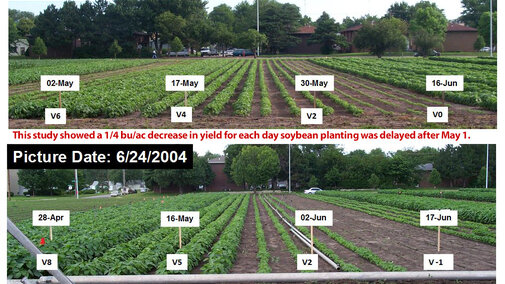Data continues to suggest growers are planting soybean earlier than ever before. In fact, over the past three decades, farmers have persistently shifted average soybean planting dates in the North Central U.S. to earlier calendar dates at a rate of ½ day per year (Specht et al., 2014). A study surveying soybean growers throughout the north central U.S. in 2014-2015 looked at factors that influenced soybean yields. Survey data of 3,568 field-year observations from rainfed and irrigated soybean fields found planting date to be the most consistent management factor increasing soybean yield (Rattalino Edreira et al., 2017, Mourtzinis, et al. 2018).
Data from Nebraska, Iowa, South Dakota, Illinois, Indiana, Wisconsin and Ohio all show increased yields from earlier planting of soybean. Grower-reported yield data for southern and northern Nebraska in both irrigated and non-irrigated environments also shows the benefit of earlier soybean planting [and the yield penalty for delaying planting after May 1 (Figure 1)].
Key Points
- Planting soybean early is critical to maximizing yield. This has been found through numerous University studies in addition to grower-reported data.
- The relationship between maturity group and early soybean planting is not clear. Perhaps what is more important is looking at specific variety performance for varieties adapted for your area rather than selecting a specific maturity group.
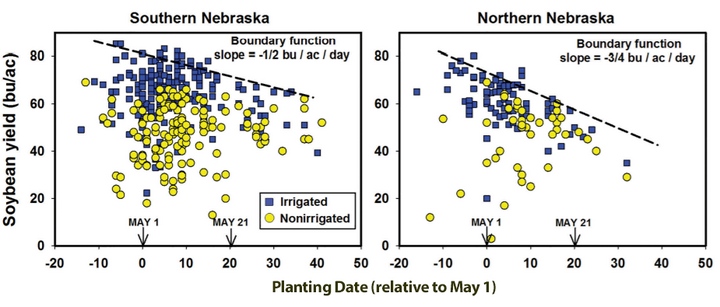
The yield benefit for planting soybean early is well established and documented. The question, perhaps in part from the data in Figure 2, now becomes: How does one amplify the positive impacts of early soybean planting? Recently growers have asked what maturity group should be used with early planting and if there’s a yield difference for early planting in irrigated versus non-irrigated environments.
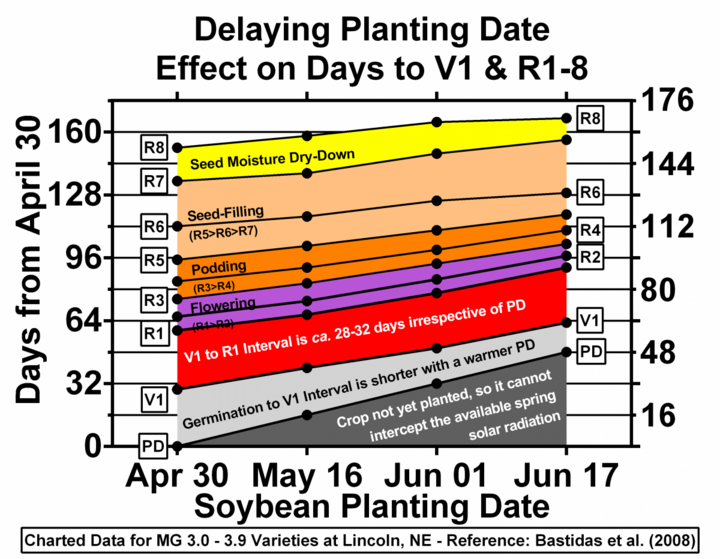
Maturity Group Considerations in Irrigated and Non-Irrigated Environments
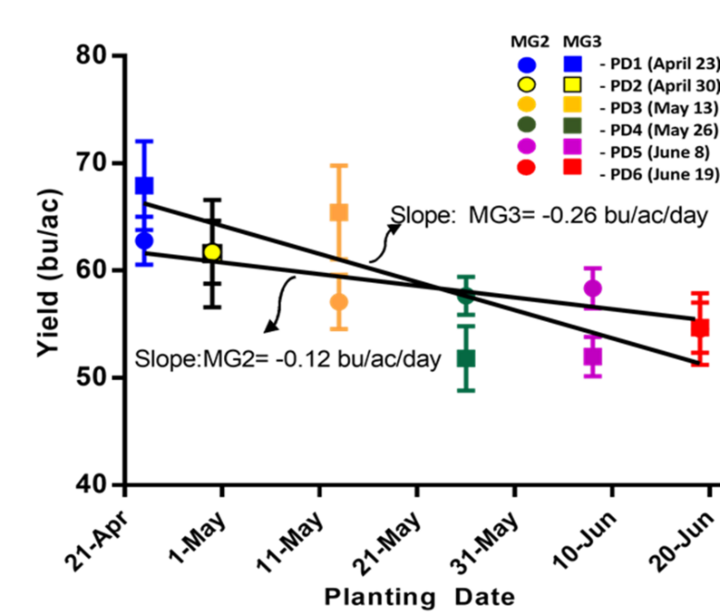
A study conducted at UNL’s East Campus compared a 2.1 and a 3.0 maturity group variety at 10-day intervals from April 23 through June 19. This was conducted in 2015 in an irrigated environment. Yield was highest for early-planted soybean with a yield penalty of 1/8 to 1/4 bu/ac per day of delay in planting for MG2.1 and MG3.0 varieties, respectively. The study also indicated that yield of the MG3.0 variety was higher relative to the MG2.1 variety in early plantings (late April and early- to mid-May), but the opposite (greater yield in MG2.1 versus MG3.0 variety) was found for late plantings (late-May and June) (Figure 3).
Producer responses to a survey on their choice of maturity group for irrigated versus rainfed fields can be seen in Figure 4. Producers in northeast Nebraska, on average, plant MG2.6 in irrigated fields but 2.8 in rainfed fields, whereas in southeast Nebraska, producers plant MG3.1 in irrigated fields and 3.3 in rainfed. In general, it appears from these data that Nebraska soybean producers use earlier MG varieties in their irrigated fields than in their rainfed ones. Extension Educators have also observed the use of earlier MG (3.0) for non-irrigated fields (in southern Nebraska). While this may seem counter-intuitive, the shorter MG for irrigated fields in southern Nebraska may be due to several reasons:
- High yielding MG2.4-2.5 genetics.
- Earlier MG helps with earlier harvest to help spread out harvest and risk.
- Early harvest for other goals such as longer window for cover crop growth planted into soybean residue, etc.
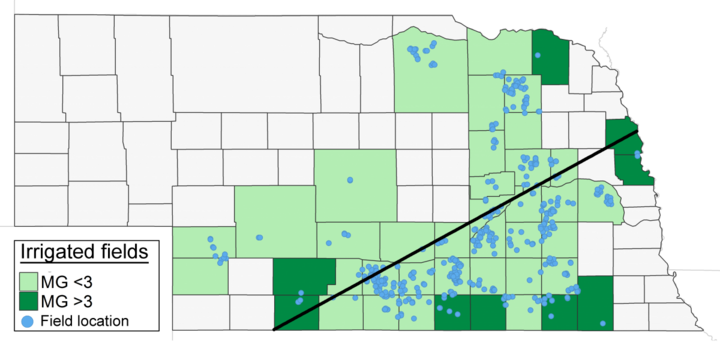
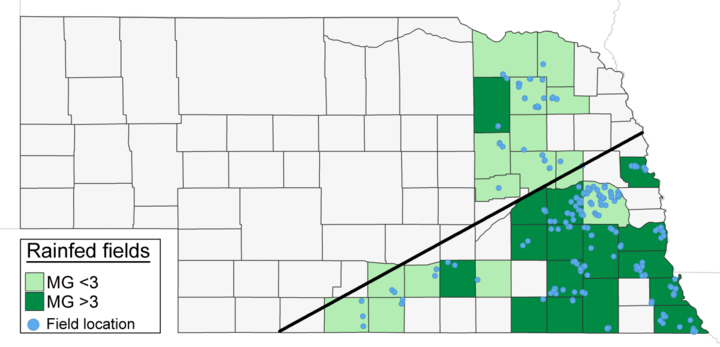
Figure 4. Nebraska producer responses to survey on soybean maturity group planted for irrigated (left) and rainfed (right) systems, collected as part of a larger survey conducted from 2013-2015 in the north central U.S. representing 909 fields, 89% of which were irrigated and 11% of which were rainfed. The line represents a very generalized suggested but not prescriptive divider between MGII (above) and MGIII (below).
The advantage of a longer MG for non-irrigated fields may be due more to water deficits that can occur during seed-fill in many years and at many locations throughout Nebraska. Late-season soil water deficits can create stress that hastens physiological maturity (R7), resulting in reduced yield. Planting these rainfed fields to longer MG can potentially shift the crop’s seed-filling timeframe to somewhat later in the growing season when the temperatures are typically lower and allow the crop more time to catch a drought-mitigating rain.
Variety Selection for Proven Yield Performance Critical Too
Third-party variety trials conducted (Figure 5) in eastern Nebraska this decade reveal that picking a variety for proven yield performance is one of the most critical yield drivers. There were top-yielding varieties across a range of relative maturities. The relative maturity of a variety explained very little of the variation in yield within a growing season. When selecting varieties first focus on proven yield performance in your region, then evaluate the relative maturity of your selections for planting order and field assignments.
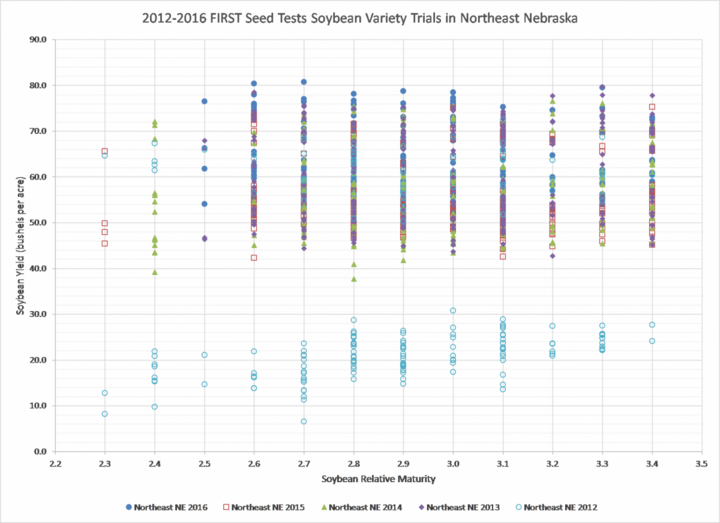
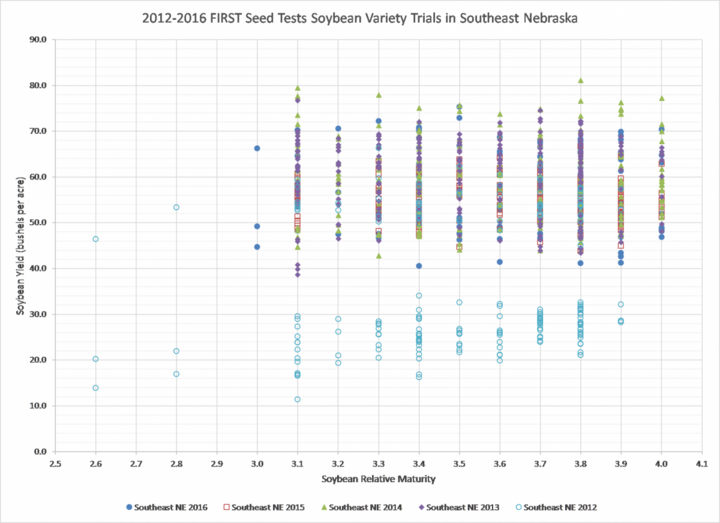
Figure 5. Soybean variety trial data conducted by FIRST Seed Tests at multiple locations per year 2012-2016 in both northeast and southeast Nebraska.
Summary
- Planting soybean early is critical to maximizing yield. This has been found through numerous University studies in addition to grower-reported data.
- The relationship between maturity group and early soybean planting is not clear. Perhaps what is more important is looking at specific variety performance for varieties adapted for your area rather than selecting a specific maturity group.
Growers still may choose not to plant soybean early due to a number of factors including: equipment constraints, tradition of planting corn prior to soybean, and weather constraints during planting. There also may be an overestimation of risk associated with seed chilling injury, early frost, and seed and/or plant stand loss associated with early planting. Ways to work around these constraints can include hiring someone to custom plant soybean at the same time as corn planting, using fungicide/insecticide seed treatments, assessing soil temperatures, and testing earlier soybean planting dates for oneself.
We have minimal data from throughout the state looking at maturity group differences with early planting dates in both irrigated and rainfed environments. If you’re interested in comparing this for yourself, consider using the Nebraska On-Farm Research Protocols.
- This Protocol allows you to compare a high-yielding MG 2.4-2.5 vs. a MG 3.0-3.5.
- This Protocol allows you to test early vs. later soybean planting for yourself.
References
Bastidas, A. M., T. D. Setiyono, Achim Dobermann, Kenneth G. Cassman, and Roger Wesley Elmore. Soybean Sowing Date: The Vegetative, Reproductive, and Agronomic Impacts. Crop Science 48:727–740.
Conley, Shawn. 2018. Soybean planting date and maturity group considerations moving into 2018. Wisconsin Extension Cool Bean. http://coolbean.info/2018/04/09/planting-date-and-maturity-group-considerations-moving-into-a-potentially-early-spring-2018/
Grassini, Patricio, Jennifer Rees, Nicolas Cafaro La Menza, and James Specht. 2016. What does it take to produce 80+ bu/ac soybean? Nebraska Extension EC3000. http://extensionpublications.unl.edu/assets/pdf/ec3000.pdf
Iowa State University. Soybean planting date can have a significant impact on yield. ISU Integrated Crop Management. https://crops.extension.iastate.edu/soybean-planting-date-can-have-significant-impact-yield
Jasa, Lisa. 2009. Adjust Maturity with Early Planted, Rainfed Soybeans. Nebraska Extension CropWatch. https://cropwatch.unl.edu/adjust-maturity-early-planted-rainfed-soybeans
Lindsey, Laura. 2017. Soybean planting date, row width, and seeding rate recommendations. Ohio State University Extension Agronomic Crops Network. https://agcrops.osu.edu/newsletter/corn-newsletter/2017-09/soybean-planting-date-row-width-and-seeding-rate-recommendations
Mourtzinis, Spyridon, Juan I. Rattalino Edreira, Patricio Grassini, Adam C. Roth, Shaun N. Casteel, Ignacio A. Ciampitti, Hans J. Kandel, Peter M. Kyverga, Mark A. Licht, Laura E. Lindsey, Daren S. Mueller, Emerson, D. Nafziger, Seth L. Naeve, Jordan Stanley, Michael J. Staton, Shawn P. Conley. 2018. Sifting and winnowing: Analysis of farmer field data for soybean in the US North-Central region. Field Crops Research 221:130-141
Mueller, Nathan, Roger Elmore, and Troy Ingram. 2017. Large Check, Small Seed, Significant Impact. Nebraska Extension CropWatch. https://cropwatch.unl.edu/2017/Large-Check-Small-Seed-Significant-Impact
Mueller, Nathan, Aaron Nygren, Jenny Rees, and Jim Specht. 2016. Adjusting for Delayed Soybean Planting. Nebraska Extension CropWatch. https://cropwatch.unl.edu/2016/adjusting-delayed-soybean-planting
Nafziger, Emerson. 2017. Planting date for corn and soybeans in Illinois. University of Illinois the Bulletin, http://bulletin.ipm.illinois.edu/?p=3848
Scoop on Soybean Blog. 2018. Early does it: Optimal soybean yields come with timely planting. South Dakota Soybean Association. https://www.sdsoybean.org/scoop-on-soybean-blog/early-does-it-optimal-soybean-yields-come-with-timely-planting/
Specht, James E., Jennifer M. Rees, Gary L. Zoubek, Keith L. Glewen, Brandy S. VanDeWalle, James W. Schneider, David L. Varner, and Allan R. Vyhnalek. Soybean planting date: When and Why? Nebraska Extension EC145. http://extensionpubs.unl.edu/publication/9000016368318/soybean-planting-date-when-and-why/
Specht, James E. and Thomas Hoegemeyer. 2017. Nebraska Soybean and Corn Pocket Field Guide, 2017 Edition.
Tenorio, Fatima Amor, P. Grassini, J. Rees, K. Glewen, N. Mueller, L. Thompson, and J. Specht. 2016. Early Bird Gets the Worm: Benefits of Early Soybean Planting. Nebraska Extension CropWatch. https://cropwatch.unl.edu/2016/early-bird-gets-worm-benefits-early-soybean-planting
